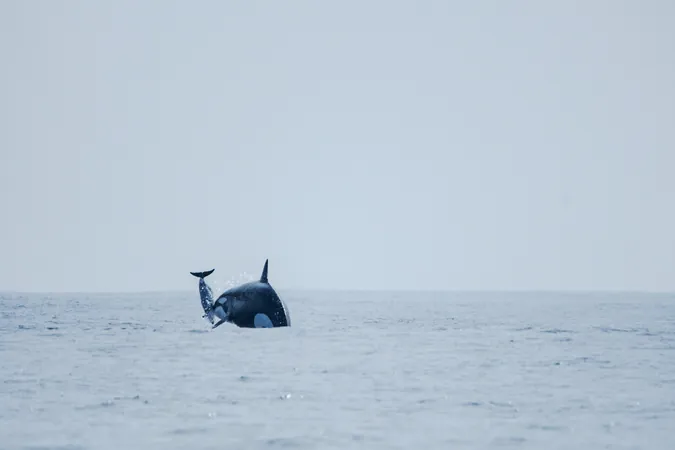
Revolutionary Orca Hunting Skills Uncovered Near Chile: Discover the Secrets of the Menacho Pod!
2024-09-26
Author: Emma
In the vibrant and nutrient-rich waters off the coast of Chile, a little-known population of orcas, known as the Menacho pod, has astounded scientists with their newly discovered hunting techniques. This groundbreaking revelation, spearheaded by Dr. Ana García Cegarra of the Universidad de Antofagasta, shines a light on the complexities of orca behavior and their significance in the marine ecosystem.
Previously documented using fishing boats to aid in capturing sea lions, the Menacho pod has now made headlines for their successful hunting of dusky dolphins—an unprecedented behavior for this group. This thrilling development not only challenges existing knowledge about their dietary habits but could also reveal critical insights into the connections between various orca populations in the southern hemisphere, which can aid in conservation efforts.
"Studying these marine giants presents unique challenges due to their vast roaming patterns and preference for offshore living, making them elusive to observe," noted Dr. García Cegarra, the lead author of the study published in Frontiers in Marine Science. "Understanding their role within the marine ecosystem is vital for the conservation of these enigmatic orcas in the Humboldt Current."
Diving Deep into Orca Diets
Orcas, or killer whales, are apex predators showcasing an extraordinary range of dietary preferences that characterize different ecotypes. While some populations, like the Type A and Type B1 orcas, predominantly hunt marine mammals, others may focus on fish. Identifying and understanding the diet of the Humboldt Current orcas is pivotal for establishing how they relate to their global counterparts.
Among the five distinct ecotypes observed in the southern hemisphere, the Menacho pod’s hunting behavior suggests it may belong to the mammal-hunting Type A category, known for their small pod sizes and specialized prey choices. However, it remains unclear why these orcas have not been spotted alongside other Type A populations in Patagonia, adding another layer of mystery to their behavioral patterns.
Using a combination of extensive surveys and citizen science contributions gathered from whale-watching excursions and fishing activities, the researchers monitored orca behaviors and prey interactions. This collaborative effort enabled the scientists to map the orca presence in their habitat, with drone footage providing a modern twist to traditional observation methods.
The jaw-dropping images captured during these hunts show Dakota, the pod's matriarch, dramatically tossing a dusky dolphin into the air—a behavior never before observed in these orcas. This startling visual evidence paints a clearer picture of their diet, suggesting they are indeed hunting dolphins similar to other apex predators.
Elusive And Intelligent: The Challenges of Studying Orcas
Despite their promising progress, Dr. García Cegarra expressed a pressing need for genetic analysis to fully understand the Menacho pod. "If only we could obtain skin biopsy samples to analyze their genetic lineage. Unfortunately, these intelligent creatures are incredibly difficult to approach when out at sea."
Sharing the Harvest
Not only did the researchers observe the hunting behavior of the Menacho pod, but they also noted a fascinating social aspect: food sharing. This instinctive behavior is prevalent among gentler orca populations, often aimed at strengthening familial ties or ensuring cooperative hunting success by distributing meals amongst pod members. In this case, it appeared that the matriarch and other females were sharing their catch with relatives, reminiscent of the sophisticated hunting strategies observed in Type A orcas.
Despite the remarkable findings, Dr. García Cegarra emphasizes the need for further systematic research to uncover more secrets about this elusive population of orcas. As our understanding of their unique hunting skills expands, so too does our responsibility to protect these extraordinary creatures and the delicate marine ecosystems they inhabit. Stay tuned, as we unveil more breathtaking discoveries from the heart of the Humboldt Current!









 Brasil (PT)
Brasil (PT)
 Canada (EN)
Canada (EN)
 Chile (ES)
Chile (ES)
 España (ES)
España (ES)
 France (FR)
France (FR)
 Hong Kong (EN)
Hong Kong (EN)
 Italia (IT)
Italia (IT)
 日本 (JA)
日本 (JA)
 Magyarország (HU)
Magyarország (HU)
 Norge (NO)
Norge (NO)
 Polska (PL)
Polska (PL)
 Schweiz (DE)
Schweiz (DE)
 Singapore (EN)
Singapore (EN)
 Sverige (SV)
Sverige (SV)
 Suomi (FI)
Suomi (FI)
 Türkiye (TR)
Türkiye (TR)